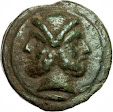Aes Formatum Palm Tree, Triangular Bar and Tear Drop Shapes
Two interesting cast bronze pieces arrived this week. The top photo shows them next to the Currency Bar I described below.
Ramo Secco Bar (826 grams)
Palm Shaped cast plate (29.3 grams)
Triangular Bar (14.9 grams)
The
palm shaped bronze piece was described as an Aes Formatum from Central Italy (Etruria
or Lazio) produced in the 6th to 4th centuries BC. I found five
examples on line of sales, including mine. I did not find any in reference books for
Roman Republican coins or Italian Cast bronze (Crawford, RRC; Gruber, BMCRR (or
BMC on line); Sydenham, AG or CRR; Sear; Thurlow & Vecci, ICC&AG;
Vecci, ICC; Haberline, AG; Garrucci, LMDIA; Kircheriano, AG; Alteri, AGL; etc. I did not find any offered by NAC or CNG.
|
|
Seller
|
L, mm
|
W, mm
|
T, mm
|
Wt, gr
|
Price $
|
Comments
|
|
1
|
MHSL
|
65.5
|
23.5
|
6
|
29.34
|
|
mine
|
|
2
|
MHSL,
AA
|
|
|
|
21.66
|
181
|
|
|
3
|
MHSL
|
|
|
|
12.83
|
130
|
|
|
4
|
ROMA
|
78
|
30
|
|
90.4
|
263
|
|
|
5
|
AA
|
|
|
|
22.5
|
105
|
Hammer
price in euro
|
|
6
|
MSHL
|
|
|
|
22.2
17.7
|
|
I found two more in a blog
|
The seller had enough information to identify this one from Central Italy (Etruria or Lazio) to the 6th to 4th century BC. I do not find a reference book (or web site) with this piece.
The seller's description:
Aes
Formatum. Siglos VI-IV a.C. ETRURIA o LAZIO. Anv.: Elemento en forma de
palmera. 29,34 grs. AE. Ø 65x24 mm. Pátina marrón. (Pequeñas concreciones
oscuras). MBC.
The seller's description:
Celtiberian, Copper
Ingot, Centuries BC-AD PREMONEDAS IN HISPANIA. Anv .: Ingot triangular. 14.92
grams. AE. Ø 35x12 mm. Dark patina. AB-P.34. MBC.
I found more examples sales of this type of bronze online and examples in one book:
Garrucci – Table VI #5
& #6
This tear drop shaped piece was described as an Aes Formatum from Central Italy (Etruria or Lazio) produced in the 6th to 4th centuries BC. I found four examples on line of sales, including mine. I did not find any in reference books for Roman Republican coins, but I did find an example in Vecchi, Italian Cast Coinage.
Vecci, ICC – pg 90, #6
The seller's description:
AES Formatum 49 mm . long. VI- IV centuries
B.C. ETRURIA or LAZIO . 48.10 grams. AE . Green patina . I. Vecchi Nummorum
auctioned by 1999. Auctiones similar piece of different dimensions. EBC .
Soler y Llach Auction International S.A.



















